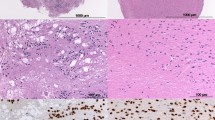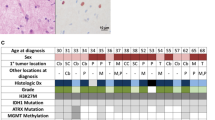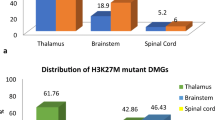Abstract
Introduction
Diffuse midline glioma (DMG) H3 K27-altered is a type of high-grade gliomas first recognized as a new entity in the 2016 World Health Organization Classification of Central Nervous System (CNS) Tumors as DMG H3 K27M-mutant, recently renamed in the new 2021 WHO classification. The aim of this review is to describe the characteristics of diffuse midline gliomas H3 K27-altered in the adult population.
Methods
We performed a review of the current literature regarding the genetic, clinical, imaging characteristics and management of diffuse midline gliomas H3 K27-altered in adult patients.
Results
The 2021 WHO classification now designates the previously recognized DMG H3K27M-mutant as DMG H3 K27-altered, recognizing the alternative mechanisms by which the pathogenic pathway can be altered. Thus, the diagnostic criteria for this entity consist of diffuse growth pattern, midline anatomic location, and H3 K27-specific neuroglial mutations. DMGs’ characteristic midline location makes them difficult to surgically resect and biopsy, carrying high mortality and morbidity rates, with median survival ranging from 9 to 12 months in adult patients.
Conclusion
The diagnosis of DMGs H3 K27-altered in adult patients should be considered upon neurological symptoms associated with an infiltrative midline brain tumor detected on imaging. Future studies are necessary to continue refining their characteristics in this age group.




Similar content being viewed by others
References
Louis DN, Perry A, Reifenberger G, von Deimling A, Figarella-Branger D, Cavenee WK et al (2016) The 2016 world health organization classification of tumors of the central nervous system: a summary. Acta Neuropathol 131:803–820. https://doi.org/10.1007/s00401-016-1545-1
Louis DN, Perry A, Wesseling P, Brat DJ, Cree IA, Figarella-Branger D et al (2021) The 2021 WHO classification of tumors of the central nervous system: a summary. Neuro Oncol 23:1231–1251. https://doi.org/10.1093/neuonc/noab106
Schreck KC, Ranjan S, Skorupan N, Bettegowda C, Eberhart CG, Ames HM et al (2019) Incidence and clinicopathologic features of H3 K27M mutations in adults with radiographically-determined midline gliomas. J Neurooncol. https://doi.org/10.1007/s11060-019-03134-x
Yoon HI, Wee CW, Kim YZ, Seo Y, Im JH, Dho Y-S et al (2021) The Korean society for neuro-oncology (KSNO) guideline for adult diffuse midline Glioma: version 2021.1. Brain Tumor Res Treat 9:1
Schulte JD, Buerki RA, Lapointe S, Molinaro AM, Zhang Y, Villanueva-Meyer JE et al (2020) Clinical, radiologic, and genetic characteristics of histone H3 K27M-mutant diffuse midline gliomas in adults. Neuro-Oncol Adv. https://doi.org/10.1093/noajnl/vdaa142
Bai J, Varghese J, Jain R (2020) Adult glioma WHO classification update, genomics, and imaging: what the radiologists need to know. Top Magn Reson Imaging 29:71–82. https://doi.org/10.1097/RMR.0000000000000234
Meyronet D, Esteban-Mader M, Bonnet C, Joly MO, Uro-Coste E, Amiel-Benouaich A et al (2017) Characteristics of H3 K27M-mutant gliomas in adults. Neuro Oncol 19:1127–1134. https://doi.org/10.1093/neuonc/now274
Park C, Kim TM, Bae JM, Yun H, Kim JW, Choi SH et al (2021) Clinical and genomic characteristics of adult diffuse midline glioma. Cancer Res Treat 53:389–398. https://doi.org/10.4143/CRT.2020.694
Himes BT, Zhang L, Daniels DJ (2019) Treatment strategies in diffuse midline gliomas with the H3K27M mutation: the role of convection-enhanced delivery in overcoming anatomic challenges. Front Oncol 9:1–10. https://doi.org/10.3389/fonc.2019.00031
Santisukwongchote S, Teerapakpinyo C, Chankate P, Techavichit P, Boongird A, Sathornsumetee S et al (2021) Simplified approach for pathological diagnosis of diffuse gliomas in adult patients. Pathol Res Pract 223:153483. https://doi.org/10.1016/j.prp.2021.153483
Dono A, Takayasu T, Ballester LY, Esquenazi Y (2020) Adult diffuse midline gliomas: clinical, radiological, and genetic characteristics. J Clin Neurosci 82:1–8. https://doi.org/10.1016/j.jocn.2020.10.005
Wang L, Li Z, Zhang M, Piao Y, Chen L, Liang H et al (2018) H3 K27M—mutant diffuse midline gliomas in different anatomical locations. Hum Pathol 78:89–96. https://doi.org/10.1016/j.humpath.2018.04.015
Aboian MS, Solomon DA, Felton E, Mabray MC, Villanueva-Meyer JE, Mueller S et al (2017) Imaging characteristics of pediatric diffuse midline gliomas with histone H3 K27M mutation. Am J Neuroradiol 38:795–800. https://doi.org/10.3174/ajnr.A5076
Enomoto T, Aoki M, Hamasaki M, Abe H, Nonaka M, Inoue T et al (2020) Midline glioma in adults: clinicopathological, genetic, and epigenetic analysis. Neurol Med Chir (Tokyo) 60:136–146. https://doi.org/10.2176/nmc.oa.2019-0168
Schwartzentruber J, Korshunov A, Liu XY, Jones DTW, Pfaff E, Jacob K et al (2012) Driver mutations in histone H3.3 and chromatin remodelling genes in paediatric glioblastoma. Nature 482:226–31. https://doi.org/10.1038/nature10833
Jain SU, Rashoff AQ, Krabbenhoft SD, Hoelper D, Do TJ, Gibson TJ et al (2020) H3 K27M and EZHIP impede H3K27-methylation spreading by inhibiting allosterically stimulated PRC2. Mol Cell 80:726–735. https://doi.org/10.1016/j.molcel.2020.09.028
Bender S, Tang Y, Lindroth AM, Hovestadt V, Jones DTW, Kool M et al (2013) Reduced H3K27me3 and DNA hypomethylation are major drivers of gene expression in K27M mutant pediatric high-grade gliomas. Cancer Cell 24:660–672. https://doi.org/10.1016/j.ccr.2013.10.006
Findlay IJ, De Iuliis GN, Duchatel RJ, Jackson ER, Vitanza NA, Cain JE et al (2022) Pharmaco-proteogenomic profiling of pediatric diffuse midline glioma to inform future treatment strategies. Oncogene 41:461–475. https://doi.org/10.1038/s41388-021-02102-y
Castel D, Kergrohen T, Tauziède-Espariat A, Mackay A, Ghermaoui S, Lechapt E et al (2020) Histone H3 wild-type DIPG/DMG overexpressing EZHIP extend the spectrum diffuse midline gliomas with PRC2 inhibition beyond H3-K27M mutation. Acta Neuropathol 139:1109–1113. https://doi.org/10.1007/s00401-020-02142-w
Antin C, Tauziède-Espariat A, Debily MA, Castel D, Grill J, Pagès M et al (2020) EZHIP is a specific diagnostic biomarker for posterior fossa ependymomas, group PFA and diffuse midline gliomas H3-WT with EZHIP overexpression. Acta Neuropathol Commun 8:183. https://doi.org/10.1186/s40478-020-01056-8
Jain SU, Do TJ, Lund PJ, Rashoff AQ, Diehl KL, Cieslik M et al (2019) PFA ependymoma-associated protein EZHIP inhibits PRC2 activity through a H3 K27M-like mechanism. Nat Commun. https://doi.org/10.1038/s41467-019-09981-6
Argersinger DP, Rivas SR, Shah AH, Jackson S, Heiss JD (2021) New developments in the pathogenesis, therapeutic targeting, and treatment of h3k27m-mutant diffuse midline glioma. Cancers (Basel). https://doi.org/10.3390/cancers13215280
Solomon DA, Wood MD, Tihan T, Bollen AW, Gupta N, Phillips JJJ et al (2016) Diffuse midline gliomas with histone H3-K27M mutation: a series of 47 cases assessing the spectrum of morphologic variation and associated genetic alterations. Brain Pathol 26:569–580. https://doi.org/10.1111/bpa.12336
Georgescu MM, Islam MZ, Li Y, Circu ML, Traylor J, Notarianni CM et al (2020) Global activation of oncogenic pathways underlies therapy resistance in diffuse midline glioma. Acta Neuropathol Commun 8:1–17. https://doi.org/10.1186/s40478-020-00992-9
Haase S, Nuñez FM, Gauss JC, Thompson S, Brumley E, Lowenstein P et al (2020) Hemispherical pediatric high-grade glioma: molecular basis and therapeutic opportunities. Int J Mol Sci 21:1–25. https://doi.org/10.3390/ijms21249654
Pathania M, De Jay N, Maestro N, Harutyunyan AS, Nitarska J, Pahlavan P et al (2017) H3.3K27M cooperates with Trp53 loss and PDGFRA gain in mouse embryonic neural progenitor cells to induce invasive high-grade gliomas. Cancer Cell 32:684-700.e9. https://doi.org/10.1016/j.ccell.2017.09.014
Schüller U, Iglauer P, Dorostkar MM, Mawrin C, Herms J, Giese A et al (2021) Mutations within FGFR1 are associated with superior outcome in a series of 83 diffuse midline gliomas with H3F3A K27M mutations. Acta Neuropathol 141:323–325. https://doi.org/10.1007/s00401-020-02259-y
Picca A, Berzero G, Bielle F, Touat M, Savatovsky J, Polivka M et al (2018) FGFR1 actionable mutations, molecular specificities, and outcome of adult midline gliomas. Neurology 90:e2086–e2094. https://doi.org/10.1212/WNL.0000000000005658
Khuong-Quang DA, Buczkowicz P, Rakopoulos P, Liu XY, Fontebasso AM, Bouffet E et al (2012) K27M mutation in histone H3.3 defines clinically and biologically distinct subgroups of pediatric diffuse intrinsic pontine gliomas. Acta Neuropathol 124:439–47. https://doi.org/10.1007/s00401-012-0998-0
Li Q, Dong F, Jiang B, Zhang M (2021) Exploring MRI characteristics of brain diffuse midline gliomas with the H3 K27M mutation using radiomics. Front Oncol 11:1–9. https://doi.org/10.3389/fonc.2021.646267
Price G, Bouras A, Hambardzumyan D, Hadjipanayis CG (2021) Current knowledge on the immune microenvironment and emerging immunotherapies in diffuse midline glioma. EBioMedicine 69:103453. https://doi.org/10.1016/j.ebiom.2021.103453
Meel MH, Kaspers GJL, Hulleman E (2019) Preclinical therapeutic targets in diffuse midline glioma. Drug Resist Updat 44:15–25. https://doi.org/10.1016/j.drup.2019.06.001
Jiang H, Yang K, Ren X, Cui Y, Li M, Lei Y et al (2020) Diffuse midline glioma with an H3 K27M mutation: a comparison integrating the clinical, radiological, molecular features between adult and pediatric patients. Neuro-Oncology. https://doi.org/10.1093/neuonc/noz152/5554271
Kleinschmidt-DeMasters BK, Levy JMM (2018) H3 K27M-mutant gliomas in adults vs. Children share similar histological features and adverse prognosis. Clin Neuropathol 37:53–63. https://doi.org/10.5414/NP301085
Zheng L, Gong J, Yu T, Zou Y (2022) Diffuse midline gliomas with histone H3 K27M mutation in adults and children. Am J Surg Pathol. https://doi.org/10.1097/PAS.0000000000001897
Lu VM, Alvi MA, Mcdonald KL, Daniels DJ (2018) Impact of the H3K27M mutation on survival in pediatric high-grade glioma: a systematic review and meta-analysis. J Neurosurg: Pediatr. https://doi.org/10.3171/2018.9.PEDS18419
Daoud EV, Rajaram V, Cai C, Oberle RJ, Martin GR, Raisanen JM et al (2018) Adult brainstem gliomas with H3K27M mutation: Radiology, pathology, and prognosis. J Neuropathol Exp Neurol 77:302–311. https://doi.org/10.1093/jnen/nly006
Dufour C, Perbet R, Leblond P, Vasseur R, Stechly L, Pierache A et al (2020) Identification of prognostic markers in diffuse midline gliomas H3K27M-mutant. Brain Pathol 30:179–190. https://doi.org/10.1111/bpa.12768
Louis DN, Giannini C, Capper D, Paulus W, Figarella-Branger D, Lopes MB et al (2018) cIMPACT-NOW update 2: diagnostic clarifications for diffuse midline glioma, H3 K27M-mutant and diffuse astrocytoma/anaplastic astrocytoma. IDH-mutant Acta Neuropathol 135:639–642. https://doi.org/10.1007/s00401-018-1826-y
Gu Q, Huang Y, Zhang H, Jiang B (2021) Case report: five adult cases of H3K27-altered diffuse midline glioma in the spinal cord. Front Oncol. https://doi.org/10.3389/fonc.2021.701113
Qiu T, Chanchotisatien A, Qin Z, Wu J, Du Z, Zhang X et al (2020) Imaging characteristics of adult H3 K27M-mutant gliomas. J Neurosurg 133:1662–1670. https://doi.org/10.3171/2019.9.JNS191920
Banan R, Akbarian A, Samii M, Samii A, Bertalanffy H, Lehmann U et al (2021) Diffuse midline gliomas, H3 K27M-mutant are associated with less peritumoral edema and contrast enhancement in comparison to glioblastomas, H3 K27M-wildtype of midline structures. PLoS ONE 16:e0249647. https://doi.org/10.1371/journal.pone.0249647
Thust S, Micallef C, Okuchi S, Brandner S, Kumar A, Mankad K et al (2021) Imaging characteristics of H3 K27M histone-mutant diffuse midline glioma in teenagers and adults. Quant Imaging Med Surg 11:43–56. https://doi.org/10.21037/QIMS-19-954
Jung JS, Choi YS, Ahn SS, Yi S, Kim SH, Lee SK (2019) Differentiation between spinal cord diffuse midline glioma with histone H3 K27M mutation and wild type: comparative magnetic resonance imaging. Neuroradiology 61:313–322. https://doi.org/10.1007/s00234-019-02154-8
Wang Y, Feng LL, Ji PG, Liu JH, Guo SC, Zhai YL et al (2021) Clinical features and molecular markers on diffuse midline gliomas with H3K27M mutations: A 43 cases retrospective cohort study. Front Oncol. https://doi.org/10.3389/fonc.2020.602553
Feng J, Hao S, Pan C, Wang Y, Wu Z, Zhang J et al (2015) The H3.3 K27M mutation results in a poorer prognosis in brainstem gliomas than thalamic gliomas in adults. Hum Pathol 46:1626–32. https://doi.org/10.1016/j.humpath.2015.07.002
Hassan U, Latif M, Yousaf I, Bin Anees S, Mushtaq S, Akhtar N et al (2021) Morphological spectrum and survival analysis of diffuse midline glioma with H3K27M mutation. Cureus 13:4–12. https://doi.org/10.7759/cureus.17267
Karremann M, Gielen GH, Hoffmann M, Wiese M, Colditz N, Warmuth-Metz M et al (2018) Diffuse high-grade gliomas with H3 K27M mutations carry a dismal prognosis independent of tumor location. Neuro Oncol 20:123–131. https://doi.org/10.1093/neuonc/nox149
Chen H, Hu W, He H, Yang Y, Wen G, Lv X (2019) Noninvasive assessment of H3 K27M mutational status in diffuse midline gliomas by using apparent diffusion coefficient measurements. Eur J Radiol 114:152–159. https://doi.org/10.1016/j.ejrad.2019.03.006
Basit Khan A, Matsuoka CK, Lee S, Rahman M, Rao G (2021) Prolonged survival after laser interstitial thermal therapy in glioblastoma. Surg Neurol Int 12:1–4. https://doi.org/10.25259/SNI_174_2021
Smith CJ, Fairres MJ, Myers CS, Chapple KM, Klysik M, Karis JP et al (2019) Long-term outcome data from 121 patients treated with Gamma Knife stereotactic radiosurgery as salvage therapy for focally recurrent high-grade gliomas. J Radiosurgery SBRT 6:199–207
Ding C, Saw CB, Timmerman RD (2018) Cyberknife stereotactic radiosurgery and radiation therapy treatment planning system. Med Dosim 43:129–140. https://doi.org/10.1016/j.meddos.2018.02.006
De Franca SA, Tavares WM, Salinet ASM, Teixeira MJ, Paiva WS (2020) Laser interstitial thermal therapy as an adjunct therapy in brain tumors: a meta-analysis and comparison with stereotactic radiotherapy. Surg Neurol Int 11:1–15. https://doi.org/10.25259/SNI_152_2020
Tong BC-K (2017) 乳鼠心肌提取 HHS public access. Physiol Behav 176:139–48. https://doi.org/10.1007/s11060-019-03271-3.Pediatric
Hall MD, Odia Y, Allen JE, Tarapore R, Khatib Z, Niazi TN et al (2019) First clinical experience with DRD2/3 antagonist ONC201 in H3 K27M–mutant pediatric diffuse intrinsic pontine glioma: a case report. J Neurosurg Pediatr 23:719–725. https://doi.org/10.3171/2019.2.PEDS18480
Gardner SL, Allen JC, Zaky WT, Odia Y, Daghistani D, Khatib Z et al (2019) ONC201 in previously-irradiated pediatric H3 K27M-mutant glioma. J Clin Oncol 37:10046. https://doi.org/10.1200/JCO.2019.37.15_suppl.10046
Arrillaga-Romany I, Kurz S, Tarapore R, Lu G, Sumrall A, Butowski N et al (2021) LTBK-05. clinical efficacy OF ONC201 in recurrent H3 K27M-mutant diffuse midline glioma patients. Neuro Oncol 23:230–230. https://doi.org/10.1093/neuonc/noab196.925
Gojo J, Pavelka Z, Zapletalova D, Schmook MT, Mayr L, Madlener S et al (2020) Personalized treatment of H3K27M-mutant pediatric diffuse gliomas provides improved therapeutic opportunities. Front Oncol 9:1–14. https://doi.org/10.3389/fonc.2019.01436
Lu VM, Alvi MA, McDonald KL, Daniels DJ (2019) Impact of the H3K27M mutation on survival in pediatric high-grade glioma: a systematic review and meta-analysis. J Neurosurg Pediatr 23:308–316. https://doi.org/10.3171/2018.9.PEDS18419
Acknowledgements
The authors thank Alan Ulises López Pérez for reviewing and revising the manuscript.
Funding
No funding was received to assist with the preparation of this manuscript.
Author information
Authors and Affiliations
Contributions
VGN had the idea for the article. CAL-P, XF-M and RV-G performed the literature search, data analysis and drafted the work. VGN and AD-A critically revised the work. MAR-F, MD., provided the radiological and histopathological images.
Corresponding author
Ethics declarations
Conflict of interest
The authors have no relevant financial or non-financial interests to disclose.
Additional information
Publisher's Note
Springer Nature remains neutral with regard to jurisdictional claims in published maps and institutional affiliations.
Rights and permissions
About this article
Cite this article
López-Pérez, C.A., Franco-Mojica, X., Villanueva-Gaona, R. et al. Adult diffuse midline gliomas H3 K27-altered: review of a redefined entity. J Neurooncol 158, 369–378 (2022). https://doi.org/10.1007/s11060-022-04024-5
Received:
Accepted:
Published:
Issue Date:
DOI: https://doi.org/10.1007/s11060-022-04024-5




